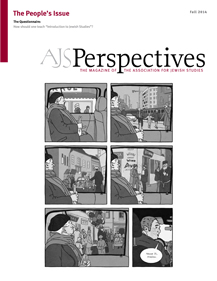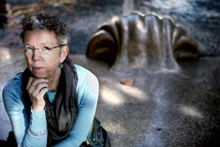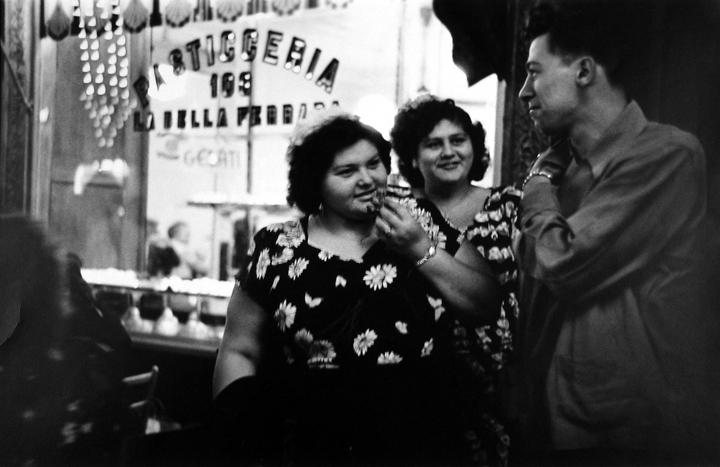
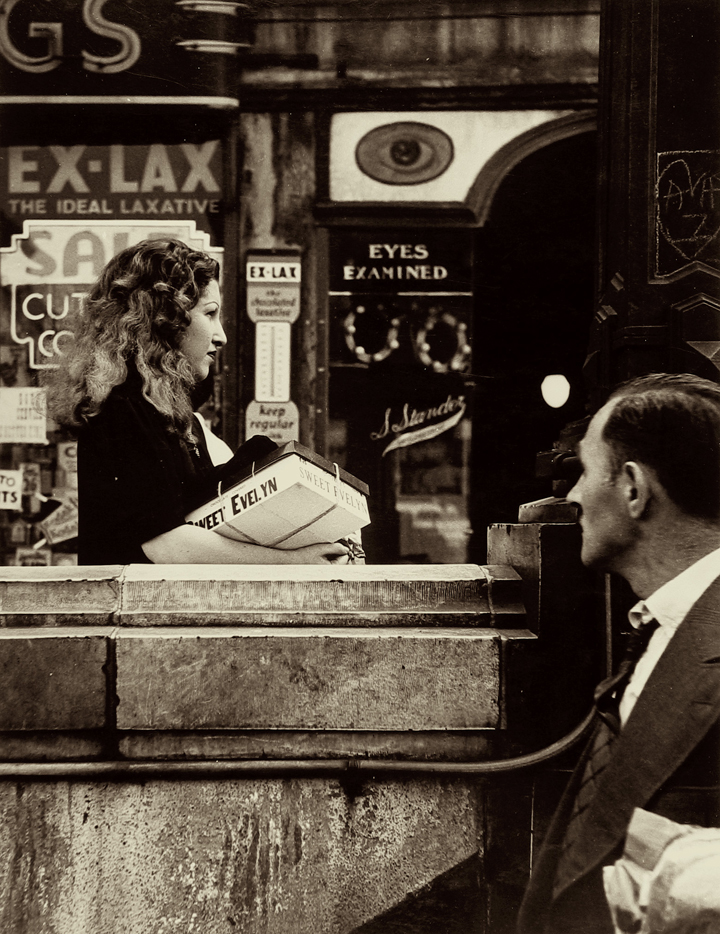
The experience of hundreds of young aspiring Jewish photographers at the New York Photo League not only created an archive of rough images of city streets but also a distinctive tradition of street photography that was indebted to lively, intense conversations about photography that occurred at the league. This heritage of street photography extended beyond the league's demise in 1951, through the teaching of former league members, and through interlocking circles of photographers located in New York City. But even before the league succumbed to anti-communist agitation that landed it on the Attorney General's list in 1947, World War II disrupted the collective spirit of league photographers. Several of its leaders, including Grossman and Walter Rosenbaum, were drafted into the armed forces and served overseas. After the war a more individual, personal, form of street photography, often focused on interactive portraits, emerged.
This type of photo ethnography inscribed acts of looking with an existential significance that questioned the reality of the lives portrayed. Photographs through plate glass windows, always fascinating to photographers for their reflective virtues, invited contemplation of the unreality of urban existence, the interpenetration of inside and outside, the topsy-turvy world of signifiers pointing wildly to each other. Looks stolen provoked an uneasy sense of urban chaos, a disorder and craziness pictured by photographers. Pictures of public performances that transformed profane space into sacred turf transported viewers beyond the streets to contemplate human relations. Here could be seen a frozen moment that raised questions about attitudes toward neighbors.
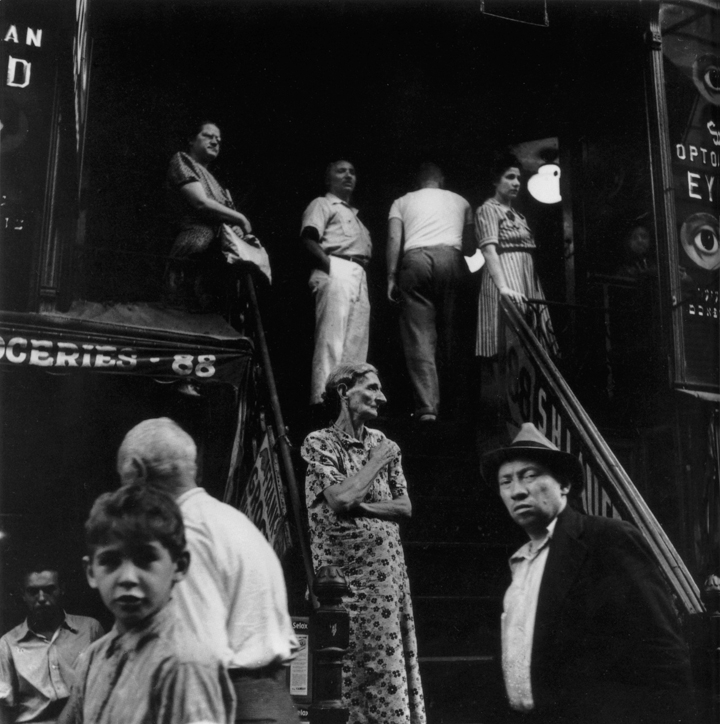
These changes in Jewish photographers' understanding of their enterprise stemmed in part from a movement away from collective responsibility for urban images to individual encounters on city streets. Although photographers continued to share their images and learn from each other in classes with master teachers, they increasingly adopted an ethnographic posture of participant observer. They sought simultaneously to picture mundane urban life and to reflect upon it. Their pictures transformed everyday sights concretely exemplified in photos of ordinary people into both ethnographic evidence and works of art. Viewing the circumstances of existence, of life as lived, stimulates reflection upon the fabric of social life. This postwar move by photographers from sociologically engaged street photography to existentially intriguing city people paralleled an emphasis among social scientists on theories of interaction as the glue connecting urban residents. Ties of kinship and metaphors of family connections describe this shift in perceptions. Yet the alienation of urban strangers, first remarked upon and theorized by the German sociologist, Georg Simmel, also endured.
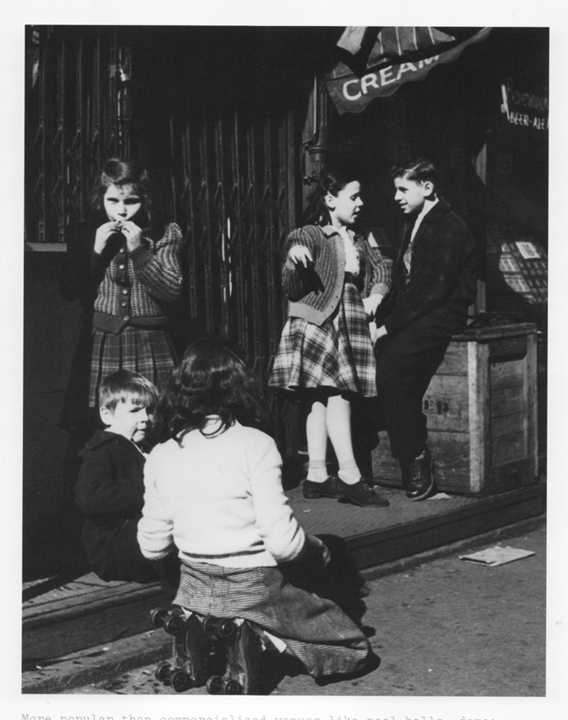
Jewish street photographers seem to collude with viewers, suggesting a shared responsibility for looking. Far from objectifying the people they portrayed, the pictures seem both abrasive and evanescent. How can one hold onto the moment of insight? How does existence depend upon what is permitted to be seen? What images endure and enter a metaphoric communal family album? These photographs will become collective memories of an urban past. They offer future generations insights into an unselfconscious Jewish world that was transformed by Holocaust and Cold War into highly self-conscious perspectives.
The league attracted largely working-class Jews, native New Yorkers, who discovered photography, were passionate about its possibilities, and wanted to learn basic techniques. They came to the league for classes in how to take pictures that encouraged them to acquire a language for talking about photography. Like many second-generation New York Jewish organizations, the league was not explicitly Jewish. Most members possessed Jewish urban backgrounds that seldom needed or wanted articulation. Photography united them, but so did progressive and leftist politics. Photo League members shared no love for capitalism and championed socially responsible government welfare. Yet they also eschewed a politicized photography focused on strikes, pickets, rallies, and evictions. Their method often involved groups of photographers working together to document a neighborhood or street, considered the constitutive urban units of community.
The commitment of Photo League members to street photography and the documentary mode of presentation grew out of their desire to stimulate communal self-awareness and to effect social change. "The Photo League members were encouraging art with social purpose, photography that could improve living conditions and better civil liberties," writes Lili Corbus Bezner in her book, Photography and Politics in America: From the New Deal into the Cold War, "and they were doing this, at times, in a language popularized by radical Depression-era politics and born from the Marxism of the Russian revolution." (24)
League members joined styles of talking and habits of looking with categories of perception. Their common fund of experiences drew upon a city of eight million, almost two million of them Jews, which made New York feel half-Jewish. Through their ongoing discussions about photography as a group activity, members came to work within linked discourses of aesthetic and social action. An unselfconscious Jewishness facilitated creative conflict among photographers and occasionally between them and their subjects.
They took different paths to the league's modest quarters near Manhattan's Union Square. Some were teenagers still in high school and curious about photography. Others came to learn darkroom skills. Despite clumsy equipment that was far from state of the art, it was better than trying to develop film at night in an apartment bathroom or kitchen. By working together with others, one received training in the technical and expressive potential of variable exposures, shutter speeds, depth of field, not to mention darkroom craft. Still others arrived through a teacher's recommendation. But irrespective of motivation, most league members stayed because they got caught up in the excitement of photography.
They took a class with Sid Grossman, a young man who considered photography a means to change the world. From Sid they learned not only about how to take pictures but also about the history of photography. If they knew nothing about art, Sid sent them to visit the Metropolitan Museum to learn. If they didn't have a political point of view, Sid pushed them to develop one. If they had never looked before at photographs, Sid encouraged them to visit the few galleries that showed photographs. And then he urged them to take photos of what they knew: New York City streets. But he also insisted that they see those streets anew, without the aid of conventions.
"An honest viewpoint. A clean lens." The Photo League announced this ideal as an aesthetic, political, and moral statement in its April 1939 issue of its newsletter, Photo Notes. League photographers demanded both objectivity and engagement. A "clean lens" portrayed metaphorically the meaning of an "honest viewpoint." The "objective" lens, as it's called technically, introduces light into an optical system. The Photo League promoted a resonant trope of clean, honest, objective, and interactive interestedness. For these street photographers technique was methodology; they endlessly debated obligations of technique and theory. Committed enthusiasts of so-called Straight Photography urged one another to take unstaged photographs of "real" people in "real" circumstances in natural light, pictures developed and printed without special darkroom manipulations. For its proponents at the league, the "straight" photo held the potential to harness a photographer's instantaneous choices—in perspective, framing, and timing—on behalf of truth, or at least of honesty. But league photographers understood that objectivity, or at least honesty, also required that they cultivate reciprocity with neighborhood residents for whom they served as a communal mirror. Their work shows how eyes that take can give as well.
The influence of the league lingered in exchanges of ideas and images, in friendships and contacts that it had nurtured and in a heritage of Jewish photographic practices that pictured the city as common ground.

